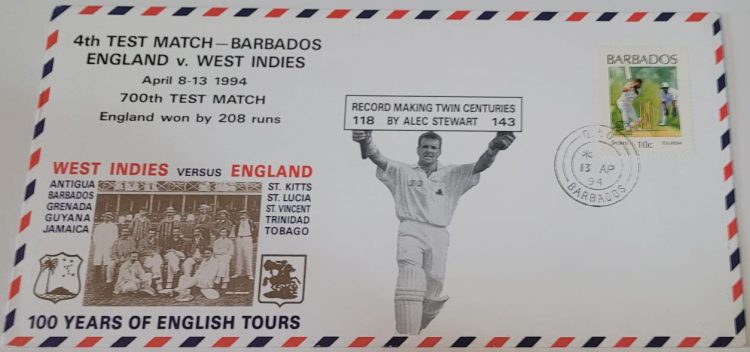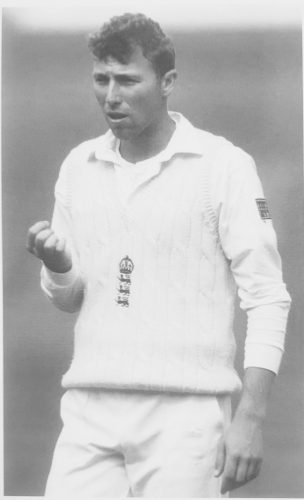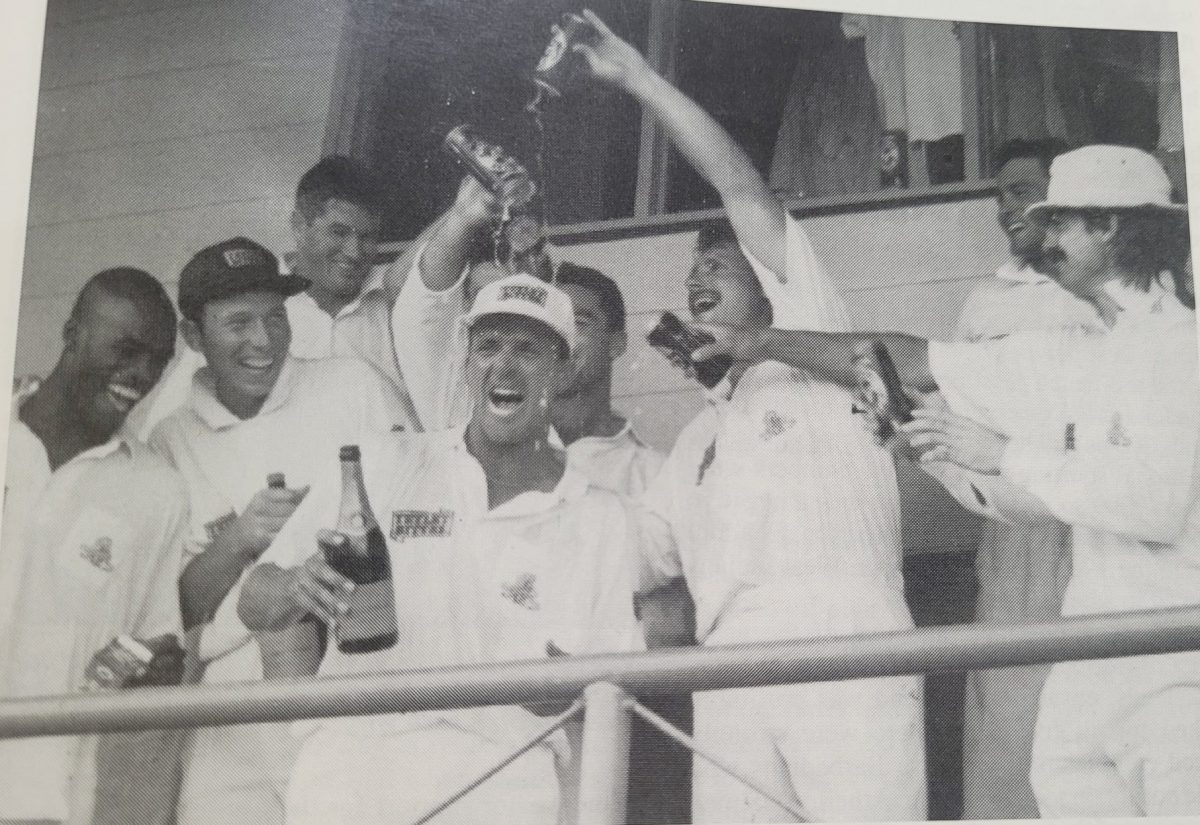In this week’s edition of In Search of West Indies Cricket, Roger Seymour looks at an historic Test match between England and the West Indies
Prologue
“Upon all the new settlements the Spaniards make, the first thing they do is build a church, the first thing the Dutch do upon a new colony is to build them a fort, but the first thing ye English do, be it in the most remote part of ye world, or amongst the most barbarous Indians, is to set up a tavern or drinking house,” attributed to English Sea Captain Thomas Walduck (who was possibly a privateer), in a letter to John Searle, his nephew in London, 1708, on the Historic London Town and Gardens website. It added, “Taverns were critical to the society, economy, and government throughout the British colonies.”

“Only 20 years after the English established the first colony here [Barbados] in 1627, there were 120 drinking houses in Bridgetown. Lying to the windward of the Caribbean island chain, Barbados had one of the best natural sea defences for a naval attack and Bridgetown became a favourite place for soldiers and sailors to recuperate from the rigours of military life…” from the chapter ‘Barbados’ in “Rums of the Eastern Caribbean” by Edward Hamilton.
The beginning
Almost four centuries later, 6th April, 1994, an English crew crawled into Bridgetown. Like a bunch of outlaws facing the inevitable gallows, they had finally arrived at their execution point, the daunting fortress of Kensington. The 1994 English cricket team to the West Indies, led by Captain Mike Atherton, were a sorry lot. Their current hosts’ 350-odd years of rum distilling experience, provided an extensive range from which to select their farewell toasts. As they drowned their sorrows, they were left to reflect on their follies which had brought them to this point.
Arriving in Antigua on 15th January, the English team won the initial warm-up game, a non-first class fixture versus an Antigua XI, 23rd – 26th January, at the Antigua Recreation Ground (ARG), by 203 runs. Scores: England 419, Alec Stewart 100 retired hurt, Atherton, 108, and 265 for three declared, Graeme Hick, 111, Graham Thorpe, 80. Antigua XI, 360, McChesney Simon,129, and 121.
The second warm-up match, also non-first class, saw the visitors held to a draw by St Kitts and Nevis, at Warner Park, St Kitts, on 29th -31st January. Scores: England, 306 for six declared, Mark Ramprakash, 136, and 184 for seven declared. St Kitts and Nevis, 258, and 22 for four.
In their opening first class fixture, England defeated the 1994 Red Stripe Cup Champions, Leeward Islands, by seven wickets, at the ARG, 3rd – 6th, February. Scores: Leeward Islands, 181, and 173. England, 312, Atherton, 77, and 44 for three.
Next stop, Bridgetown. February, 10th – 13th Kensington Oval, versus Barbados. Match drawn. Scores: Barbados, 348, Roland Holder, 85, Sherwin Campbell, 83, and 192 for five declared, Campbell, 54. England, 302, Atherton, 108, and 48 without loss.
First One Day International (ODI), Kensington Oval, 16th February. England won by 61 runs. Scores: England, 202 (5 wickets) off 50 overs, Atherton, 86. West Indies, 141 off 40.4 overs.
First Test match, Sabina Park, Kingston, Jamaica, February, 19th, 20th, 21st, 23rd , 24th. West Indies won by eight wickets. Scores: England 234, Stewart, 70, Atherton, 55, and 267, Hick, 96. West Indies, 407, Keith Arthurton, 126, Jimmy Adams, 95 not out, Brian Lara, 83, and 95 for two.
Second ODI, Sabina Park, 26th, February. West Indies won on a faster scoring rate. Scores: England 253 (8 wickets) off 50 overs, Stewart, 66, Robin Smith, 56. West Indies 240 for seven wickets off 25.5 overs, Desmond Haynes 53, Adams, 52 not out.
Third ODI, Arnos Vale, St Vincent, 1st March. West Indies won by 165 runs. Scores: West Indies, 313 (6 wickets) off 50 overs, Haynes, 83, Phil Simmons, 63, Lara, 60, Richie Richardson, 52 not out. England, 148 for nine wickets off 50 overs.
Fourth ODI, Queen’s Park Oval, Port-of-Spain, Trinidad, 5th March. West Indies won on a faster scoring rate. West Indies, 265 (7 wickets) off 45.4 overs. Haynes, 115. England, 193 for nine wickets off 36 overs.
Fifth ODI, Queen’s Park Oval, 6th March. England won on a faster scoring rate. Scores: West Indies, 250 (9 wickets) off 50 overs, Simmons, 84. England, 201 for five wickets off 36.4 overs. Stewart, 53, Atherton, 51.
West Indies won the series 3 – 2.
The middle
England versus President’s XI, at Bourda, Georgetown, Guyana, March, 10th, (11th), 12th, 13th . Match drawn. Scores: England, 308 for two declared, Ramprakash, 154 not out, Thorpe, 84, and 170 for one declared, Nasser Hussain, 103 not out. President’s XI, 181 for seven declared, Keith Semple 76, and 103 for three, Robert Samuels, 56.
Second Test match, at Bourda, March, 17th, 18th, 19th, 20th , 22nd . West Indies won by an innings and 44 runs. Scores: England, 322, Atherton, 144, Smith, 84, and 190, Stewart, 79. West Indies, 556. Lara, 167, Adams, 137, Haynes, 63, Chanderpaul (Test debut), 62.
Third Test match, at Queen’s Park Oval, March, 25th, 26th, 27th, 29th, 30th. West Indies won by 147 runs. West Indies, 252, Richardson, 63, and, 269, Chanderpaul, 50. England, 328, Thorpe, 86, Curtly Ambrose, 5 for 60, and, 46, Ambrose, 6 for 24.
At Queen’s Park, St George’s, Grenada, versus West Indies Board XI, April, 2nd – 5th. Board XI won by 8 wickets. England, 319, Ramprakash, 91, Stewart, 65, Hick, 59, and 165, Hick, 74, Ramprakash, 67. WI Board XI, 313, Roland Holder, 116, and 172 for two, Stuart Williams, 102 not out.
It was Atherton’s first overseas tour as captain, a role which he had ascended to during the previous summer’s Ashes series, taking over from Graham Gooch, for the Fifth Test, which England promptly lost by eight wickets. However, he led England to victory in the Sixth Test, their first in 18 Test matches against the Australians. It was inevitable that he would have been appointed England captain.
As a youth, he had captained Manchester Grammar School, where his outstanding performances with the bat and the ball led to selection for the England Under-19 XI, which he captained at the age of 16. In 1983, Atherton was voted the Outstanding Schoolboy Cricketer at the Under-15 level, winning the Jack Hobbs Memorial Award. After gaining acceptance to Downing College, Cambridge to read History, he was awarded a blue.
A year later, Atherton was called up to the Lancashire County side, scoring his maiden first class century two weeks after his debut. It was a busy time for Atherton, leading both Cambridge and the Combined Universities, and also playing for Lancashire. During his university days, he also led Young England Cricketers on tours to Sri Lanka and Australia.
On the morning of the 6th April, Atherton might have been musing: ‘What have I gotten myself into here? It’s been one month since we won a game. One out of nine, the last match of a dead rubber series. We lost three one days, all three Test matches – the series is over. Our eleventh defeat in 13 matches, our seventh consecutive overseas loss.The nightmare of the 46 at Port-of-Spain just never seems to end. It was our lowest total in 699 Tests since 1877, surpassing by one run the 45 total of an English side at Sydney in 1887. We let the match slip out of our hands. At 143 for five, their lead was only 67. It was Chanderpaul who swung the match and gave them something to bowl at, after we gave him two chances. Then Ambrose appeared to be in another zone for 80 minutes. It was the second consecutive Test that he dismissed me in the first over of the second innings for a duck. The only question remaining now is whether we will avoid emulating Ian Botham’s 1986 side and be ‘black-washed’ 5 – 0. Yesterday, just after the Easter weekend we succumbed to a virtual West Indies Second XI by eight wickets with two sessions to spare. It can’t get any worse than that. What an embarrassment. Even Holder, the Board Eleven, observed that we looked “shell shocked”. ‘
‘Now here we are, back in Barbados, where they haven’t lost a Test match since 1935. Twelve straight wins, and one only loss ever. 1935? Gosh, must be two lifetimes ago, in cricketing terms. What are the chances that someone has seen all those matches since then? Possible. Anything is possible. Perhaps I should be focusing on the positives and not dwelling on the negatives. We drew with Barbados and we won the first ODI here. We should have won that Third Test. There is supposed to be a sizable English contingent of cricket tourists coming down for this Test and the Antigua Test next week. Perhaps they will make a difference although the pessimistic English press think otherwise. They have been all over us, with the Daily Express proclaiming “thousands of fans will be totting up the cost of a trip to a national sporting wake”. Forget the bloody English press. Let’s concentrate on the net session today. Everything starts anew on Friday.’
England’s return to Barbados for the Fourth Test had been synchronized with an important celebration, the commemoration of the fortieth anniversary of Sir Gary Sobers’ Test debut. The programme of events had started in February and culminated during the Test match. The final week of celebrations had begun on Easter Monday with the Sir Garfield Sobers’ Race Day at the Garrison Savannah. There was a Tribute in Calypso on Sunday April 10th, which featured many of the Caribbean’s leading calypsonians, and the Sir Garfield Sobers’ Golf Tournaments, the next day, the scheduled rest day of the Test. The programme had been organised by Sobers’ former Test colleague and great friend, Wes Hall, who declared, “[It] … is to salute Sir Garry for his contributions to West Indies cricket and for the excellence with which he has clothed the game of cricket.” Did the timing of the events perhaps point to an over-confident anticipation of dual celebrations?
West Indies Skipper

Richie Richardson won the toss for the third consecutive Test, and unlike the previous match, opted to invite the visitors to bat on the bare Kensington pitch of even bounce and pace. Forgoing the knowledge of the first day scores of the season’s first class matches – Leewards 323 for 4; Jamaica 325 for 7; Barbados 289 for 6 – Richardson opted for the psychological advantage, relying on his fast bowling quartet of Ambrose, Courtney Walsh, Kenny Benjamin and Winston Benjamin to reduce England, once again, to a pile of rubble.
The end
It happened to be a grave misjudgment, as Atherton and Stewart applied the pressure to the West Indians with an opening stand of 171, as the estimated 7,000 English supporters cheered them on. The partnership was broken just before tea when Atherton, 85, poised for a well-deserved century was caught by Lara off Kenny Benjamin. Stewart, on his 31st birthday, batting with confidence duly passed the century mark. When Winston Benjamin eventually managed to sneak a delivery past Stewart’s straight bat, England were 265 for four. The opener’s innings of 118 had lasted 347 minutes, containing 18 boundaries.
The partnership had laid the groundwork for a huge English total on a true pitch, but the fragile English middle order of Ramprakash, Smith, Hick and Thorpe failed to capitalise on it. England were dismissed for 355 off 100.2 overs, on the second morning, after finishing the first day on 299 for five. The West Indies never got going as Angus Fraser tormented the entire line up. After an opening stand of 55 from Haynes and Richardson, it was a steady procession, as Fraser reduced the hosts to the appalling score of 134 for seven, with just the 19-year-old Chanderpaul and the fast bowling quartet remaining. Playing with maturity which belied his age and experience – third Test match – the teenager managed to guide the West Indies back into the game. The eighth wicket partnership with Ambrose produced 71 vital runs in two hours, and for the penultimate wicket, the young left hander, added 58 with Kenny Benjamin in one and a half hours. Ninth out for 77, Chanderpaul had notched his third half century in just his fourth Test innings. Little did the cricketing world know it was a preview of a long career of holding things together. Benjamin, 43 not out, and Walsh, 13, would further frustrate England with a half-hour, tenth wicket stand worth 41, as the West Indies clawed their way back into the match, to trail by 51. The aura of Kensington resistance was still prevailing despite Fraser’s magnificent return of eight for 75. All ten West Indian wickets had fallen to catches which said much of their discipline and shot selection.
Despite two quick wickets, those of Atherton and Ramprakash, the West Indies found themselves singing the blues at the end of play on Sunday, before heading off to the Sir Garfield Sobers Calypso Night at the just renamed – three days before – Sir Garfield Sobers Sports Complex in Wildey. England were sitting pretty heading into the rest day on 171 for three, an overall lead of 225, with Stewart, 62, and Hick, 52, well set.
Tuesday, 12th April, belonged to England, as their sun-bathed supporters revelled in their dominance. It was the second act of the Alec Stewart Show as he imposed his will on the match. Neat and dapper, with his trademark turned-up collar, Stewart put the sword to the West Indian quartet on the flat pitch, applying his deft touch to their pace, cover driving and pulling the attack apart. Stewart, more comfortable against fast bowling, was in full form, as he led England to an insurmountable total. Completing his second century of the match, as the English supporters poured onto the field to savour the rare moment of the West Indies reeling at the Kensington Oval. Stewart was eventually bowled by Walsh for 143, a monumental innings in which he defied the West Indies bowlers for eight hours less five minutes. He struck 19 fours and added 150 for the fifth wicket with Thorpe, 84. His innings afforded Atherton the rare luxury of declaring England’s second innings just after tea, at 394 for eight, leaving the hosts the daunting task of scoring 446 or surviving a minimum of 112 overs to protect the legacy of Kensington Oval.
It was not to be. The uncanny luck which had endured at Kensington began to dissipate. Haynes was unable to open after suffering a cut on his right index finger whilst batting in the first innings, pitchforking Adams into the role of opener. Neither him nor the night watchman Kenny Benjamin survived the final session. Further compounding the despairing situation was Richardson having torn his right hamstring muscle. The West Indies ended the day on 47 for two, with their supporters praying for a miracle or the unlikelihood of rain.
The West Indies duly capitulated the next day, after a glimmer of hope as Lara, miss stumped off Phil Tufnell the previous evening, and Arthurton added 81 off 18 overs. But when Lara miscued Andy Caddick, the die was cast. The last eight wickets stumbled for 109, as the hosts succumbed for 237 off 82.2 overs, having displayed no apparent strategy to try and save the match. England’s victory by 208 runs was the most improbable of results. The proud record of 59 years without defeat at the Kensington Fortress had crumbled in the dust.
Match notes
Alec Stewart was the first English batsman to complete two centuries in each innings of a Test against the West Indies. He joined the unique company of Australians Doug Walters and Greg Chappell, and India’s Little Master, Sunil Gavaskar (who did it twice) to have completed the rare feat.
Angus Fraser’s eight for 75 was the best figures for England against the West Indies.
England’s two scores of 350 plus in a Test, was the first instance against the West Indies since the 1974 Test at Sabina Park, Jamaica.
Postscript
The Fifth Test at Antigua, 16th – 21st April was drawn. Scores: West Indies, 593 for five, Lara, 375, Chanderpaul, 75 not out. England, 593. Smith, 175, Atherton, 135, Chris Lewis, 75 not out, Jack Russell, 62.
The Barmy Army, England’s touring support group was officially formed on the next overseas tour, the 1994/95 Ashes Series Down Under.






